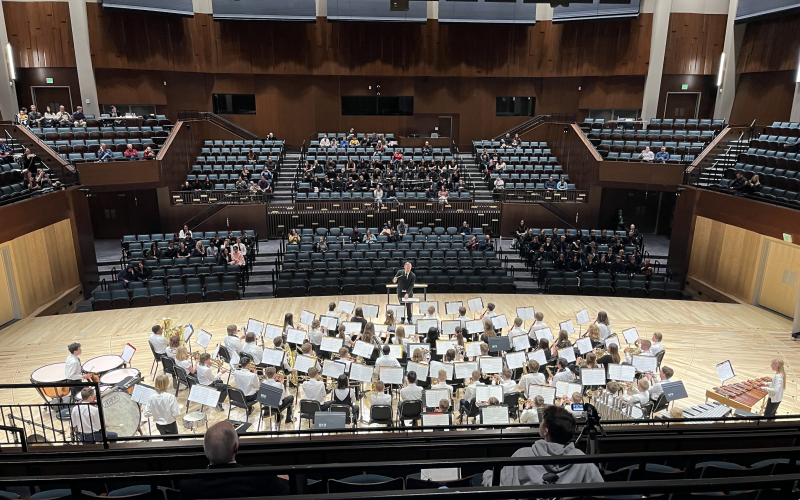BYU Band Festival Inspires Utah County Students in Grades 7-12
This March, BYU hosted 1400 students from local middle schools and high schools for a two-day concert band festival—the largest in its history. During those two days, students were able to listen to peers and college students, perform in the university’s new concert hall, see and practice adapting to different conductors and be critiqued by nationally recognized masters of music education.
BYU has hosted a concert band festival for about 20 years, according to Wind Symphony Director Shawn Smith, but this is the first year it has needed two days to accommodate all its participants. Smith attributes the growth to their new partnership with Music for All, an organization that aims to “create, provide, and expand positively life-changing experiences through music,” according to its website. “One of my first projects in joining BYU was to contact Music for All to see if they could work together to create a successful festival,” Smith said. The result is a new BYU Concert Band Festival.
It is important for BYU to not only be a supportive partner with other festival producers but also with the community, according to Smith. “It’s important for BYU to support music educators in our region and to have students learn from some of the best educators and perform on a professional stage like ours,” he said.
Peter Werner, Centennial Middle School’s band director, said the same: “I have found the process of preparing to perform at a festival an invaluable experience for my students. The amount they improve and grow as they prepare is unmatched by anything I have experienced as a band teacher.”
He added, “Hearing the BYU Wind Symphony perform was the highlight for many of my students and really inspired them.” He also said that working with this year's assigned adjudicator, Gary Hill, “was a real treat.”
Fe Packard, a trombone player in Centennial’s Wind Symphony, said Hill was particularly insightful about dynamics. “I liked the way he explained how to do piano and forte,” she said. “He said that with piano you can barely hear yourself, and with forte you can hear yourself slightly louder than the rest of the band. Putting it that way was really helpful.”
Though the festival clearly served young students, it also served the university. Some students who participate in the festival may go on to pursue an education in music at BYU.
Lyndsay Keith was a festival participant as a teenager in Provo High School’s Wind Ensemble. She later attended BYU as a music student and now works for BYU’s College of Fine Arts and Communications as the BRAVO! Series producer/presenter.
“I remember feeling so special that I got to participate,” said Keith. “It felt like such a big deal to be on the de Jong stage (at the time) playing for Dr. Kirt Saville and others who I saw as great heroes in the band world.” Keith said the festival was an inspiring factor in her applying to BYU.
Music education students also gained professional experience as they assisted with festival production.
“Prepping for this festival and seeing it run up close was a great preparatory experience for the events that I'll run in the future as a music director,” said Hadley Banner, a BYU music education student. “Being at BYU helped me to be more comfortable with this experience because of the events I've been a part of, people I've met and relationships I've developed,” she continued. “I definitely couldn't have done this by myself, and it was interesting to see the relationships and connections we had already.”
Festival benefits extended beyond classrooms and the stage to inspire families, too. Schools invited parents to chaperone and watch student performances. One of the attendees, Brenda Perry had two granddaughters in different American Fork ensembles and attended both ensembles’ performances.
“The venue and sound here have been glorious. I’ve felt the music through my bones,” Perry said. “People talk about STEM education, but we need to be talking about STEAM education and include the arts. The arts are what keep us going. They make us happy.”


